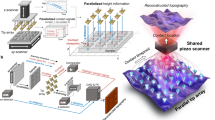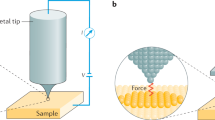Abstract
SINCE the invention of the scanning tunnelling microscope1, the value of establishing a physical connection between the macroscopic world and individual nanometre-scale objects has become increasingly evident, both for probing these objects2–4 and for direct manipulation5–7 and fabrication8–10 at the nanometre scale. While good progress has been made in controlling the position of the macroscopic probe of such devices to sub-ångström accuracy, and in designing sensitive detection schemes, less has been done to improve the probe tip itself4. Ideally the tip should be as precisely defined as the object under investigation, and should maintain its integrity after repeated use not only in high vacuum but also in air and water. The best tips currently used for scanning probe microscopy do sometimes achieve sub-nanometre resolution, but they seldom survive a 'tip crash' with the surface, and it is rarely clear what the atomic configuration of the tip is during imaging. Here we show that carbon nanotubes11,12 might constitute well defined tips for scanning probe microscopy. We have attached individual nanotubes several micrometres in length to the silicon cantilevers of conventional atomic force microscopes. Because of their flexibility, the tips are resistant to damage from tip crashes, while their slenderness permits imaging of sharp recesses in surface topography. We have also been able to exploit the electrical conductivity of nanotubes by using them for scanning tunnelling microscopy.
This is a preview of subscription content, access via your institution
Access options
Subscribe to this journal
Receive 51 print issues and online access
$199.00 per year
only $3.90 per issue
Buy this article
- Purchase on Springer Link
- Instant access to full article PDF
Prices may be subject to local taxes which are calculated during checkout
Similar content being viewed by others
References
Binnig, G. Rohrer, H., Gerber, C. & Weibel, E. Phys. Rev. Lett. 50, 120–123 (1983).
Quate, C. F. Surf. Sci. 299/300, 980–995 (1994).
Rugar, D. & Hansma, P. Phys. Today 43(10), 23 (1990).
Bustamante, C. & Keller, D. Phys. Today 48(12), 32–38 (1995).
Crommie, M. F., Lutz, C. P. & Eigler, D. M. Science 262, 218–220 (1993).
Avouris, P. Acc. Chem. Res. 27, 159–165 (1994).
Lieber, C. M., Liu, J. & Sheehan, P. E. Angew. Chem. Int. Edn Engl. 35, 687–704 (1996).
Dagata, J. A. Science 270, 1625–1626 (1995).
Minne, S. C., Flueckiger, P., Soh, H. T. & Quate, C. F. J. Vac. Sci. Technol. B 13(3), 1380–1384 (1995).
Shen, T.-C. et al. Science 268, 1590–1592 (1995).
lijima, S. Nature 354, 56–58 (1991).
Ebbesen, T. W. Physics Today 49(6), 26–32 (1996).
Colbert, D. T. et al. Science 266, 1218–1222 (1994).
Yakobson, B. I., Brabec, C. J. & Bernholc, J. Phys. Rev. Lett. 76, 2511–2514 (1996).
Spatz, J. P. et al. Nanotechnology 6, 39–44 (1995).
Weisenhorn, A. L., Hansma, P. K., Albrecht, T. R. & Quate, C. F. Appl. Phys. Lett. 54, 2651–2653 (1989).
Hansma, H. G., Laney, D. E., Bezanilla, M., Sinsheimer, R. L. & Hansma, P. K. Biophys. J. 68, 1672–1677 (1995).
Putman, C. A. J., van der Werf, K. O., de Grooth, B. G., van Hulst, N. F. & Greve, J. Biophys. J. 67, 1749–1753 (1994).
Dai, H., Wong, E. E. & Lieber, C. M. Science 272, 523–526 (1996).
Ebbesen, T. W. et al. Nature 382, 54–56 (1996).
Bard, A. J., Denuault, G., Lee, C., Mandler, D. & Wipf, D. O. Acc. Chem. Res. 23, 357–363 (1990).
Husser, O. E., Craston, D. H. & Bard, A. J. J. Electrochem. Soc. 136, 3222–3229 (1989).
Dai, H. & Lieber, C. M. Annu. Rev. Phys. Chem. 44, 237–263 (1993).
Thess, A. et al. Science 273, 483–487 (1996).
Rinzler, A. G. et al. Science 269, 1550–1553 (1995).
Treacy, M. M. J., Ebbesen, T. W. & Gibson, J. M. Nature 381, 678–680 (1996).
Yakobson, B. I., Brabec, C. J. & Bernholc, J. Phys. Rev. Lett. 76, 2511–2514 (1996).
Author information
Authors and Affiliations
Rights and permissions
About this article
Cite this article
Dai, H., Hafner, J., Rinzler, A. et al. Nanotubes as nanoprobes in scanning probe microscopy. Nature 384, 147–150 (1996). https://doi.org/10.1038/384147a0
Received:
Accepted:
Issue Date:
DOI: https://doi.org/10.1038/384147a0
This article is cited by
-
Size-dependent nonlinear stability response of perforated nano/microbeams via Fourier series
Archive of Applied Mechanics (2023)
-
Longitudinal Forced Vibration Analysis of a Single-Walled Carbon Nanotube Embedded in an Elastic Medium
Journal of Vibration Engineering & Technologies (2023)
-
Effect of vacancy defects on tensile properties of CNTs
Journal of Nanoparticle Research (2023)
-
A Review on Fracture Analysis of CNT/Graphene Reinforced Composites for Structural Applications
Archives of Computational Methods in Engineering (2022)
-
Hydrothermal from — Geology to Nanotechnology and Nanogeoscience (Part — II)
Journal of the Geological Society of India (2022)
Comments
By submitting a comment you agree to abide by our Terms and Community Guidelines. If you find something abusive or that does not comply with our terms or guidelines please flag it as inappropriate.



